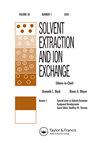Extraction of Neptunium, Plutonium, Americium, Zirconium, and Technetium by Di-(2-Ethylhexyl)-Iso-Butyramide (DEHiBA) at High Metal Loadings
IF 2.1
4区 化学
Q3 CHEMISTRY, MULTIDISCIPLINARY
引用次数: 0
Abstract
ABSTRACT Increased focus on carbon neutral energy has generated a resurgence of interest in nuclear power, and in particular advanced reactors which are likely to utilize high assay low enriched uranium (HALEU). This in turn could increase the economic attractiveness of recovering still partially enriched uranium from used nuclear fuel. Concomitant to development of advanced reactors, advanced reprocessing schemes should be developed which address the disadvantages to well established reprocessing schemes. The present study focuses on using di-(2-ethylhexyl)-iso-butyramide (DEHiBA) under high metal loading conditions for the reprocessing of used nuclear fuel. The elements examined in the study include the dominant transuranic actinides (Np, Pu, Am) as well as the often-problematic Tc and Zr. By increasing the concentration of the extractant from the more commonly reported 1.0 M – 1.5 M, the extraction of hexavalent actinides is substantially increased, while maintaining effective rejection of tri, tetra, and pentavalent actinides, particularly in the presence of high loadings of uranium. The extraction of Zr by 1.5 M DEHiBA is noted to be negligible by comparison to tributyl phosphate (TBP), however the coextraction of Tc with U is observed to be nominally twice the quantity that is extracted by TBP indicating a need for effective Tc management.高金属负荷双-(2-乙基己基)-异丁胺(DEHiBA)萃取镎、钚、镅、锆和锝
对碳中和能源的日益关注已经引起了人们对核能,特别是可能使用高含量低浓缩铀(HALEU)的先进反应堆的兴趣的复苏。这反过来又会增加从乏燃料中回收仍然部分浓缩的铀的经济吸引力。在发展先进反应堆的同时,应开发先进的后处理方案,以解决现有后处理方案的缺点。研究了在高金属负荷条件下使用二-(2-乙基己基)-异丁酰胺(DEHiBA)进行乏燃料后处理的方法。研究中检查的元素包括主要的超铀锕系元素(Np, Pu, Am)以及经常出现问题的Tc和Zr。通过增加萃取剂的浓度,从更常见的1.0 M - 1.5 M,六价锕系元素的萃取量大大增加,同时保持有效的拒绝三,四,和五价锕系元素,特别是在存在高铀负荷的情况下。与磷酸三丁酯(TBP)相比,1.5 M DEHiBA对Zr的萃取可以忽略不计,然而,与U的共萃取在名义上是TBP萃取量的两倍,这表明需要有效的Tc管理。
本文章由计算机程序翻译,如有差异,请以英文原文为准。
求助全文
约1分钟内获得全文
求助全文
来源期刊
CiteScore
4.40
自引率
5.00%
发文量
15
审稿时长
8.4 months
期刊介绍:
Solvent Extraction and Ion Exchange is an international journal that publishes original research papers, reviews, and notes that address all aspects of solvent extraction, ion exchange, and closely related methods involving, for example, liquid membranes, extraction chromatography, supercritical fluids, ionic liquids, microfluidics, and adsorption. We welcome submissions that look at: The underlying principles in solvent extraction and ion exchange; Solvent extraction and ion exchange process development; New materials or reagents, their syntheses and properties; Computational methods of molecular design and simulation; Advances in equipment, fluid dynamics, and engineering; Interfacial phenomena, kinetics, and coalescence; Spectroscopic and diffraction analysis of structure and dynamics; Host-guest chemistry, ion receptors, and molecular recognition.

 求助内容:
求助内容: 应助结果提醒方式:
应助结果提醒方式:


